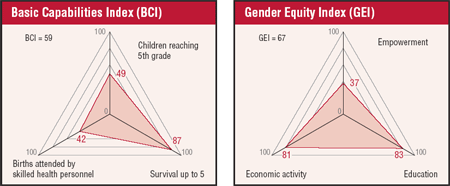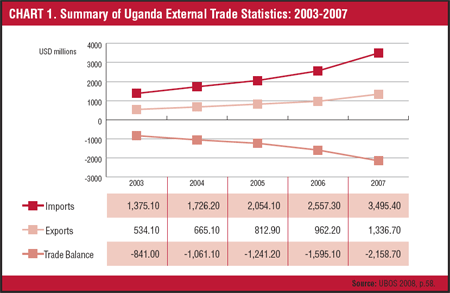Millennium Development Goals at risk
Millennium Development Goals at risk
Development Network of Indigenous Voluntary Associations (DENIVA)
David Obot
The financial crisis will hamper efforts to reduce poverty in Uganda. Foreign aid, remittances and revenues derived from exports are already shrinking. The Government must develop new strategies to help identify the root causes of poverty, exclusion and poor social conditions at home, while joining other countries at both regional and international levels in pushing for reform of the global financial architecture. Various efforts from civil society, if supported, might help to tackle the crisis.
 |
Towards the end of 2008, leaders of the G-20 called on developed and developing countries, as well as international finance institutions, to take “urgent” actions to avert the negative impacts of the global economic crisis. A World Bank report to the G-20 finance ministers’ meeting in March 2009 warned of the long-term implications for developing countries, including reduced health and education services for the poor.1
In addition, official development assistance (ODA) to poor countries may decrease as the crisis deepens in donor countries.2 The United Nations Commission on Social Development warns that the current crisis will undermine social policy and threaten social stability, with food and climate crises pushing the most vulnerable to the margins of society.3
The International Monetary Fund (IMF) has indicated that financial markets in sub-Saharan Africa are vulnerable due to the downturn in global growth and that Uganda is at risk due to borrowing for investment in the stock market.4 The Central Bank has warned that, with diminished earnings from exports and tourism, the country’s economic growth will now be in the range of 5% or 6% rather than the 8% previously projected.5
The Finance Minister has reported that while Uganda is not “directly exposed” to risk, the economic downturn could lead to a reduction of financial inflows from outside investments, tourism, remittances from abroad and aid flows from donor countries.6 He added that reduced remittances and donor support has already led to a revenue collection shortfall of UGX 108 billion (USD 51.4 million) from July 2008 to February 2009. Remittances peaked at USD 1,392 million in financial year 2007/087.
Further, foreign trade has been unimpressive. While an increase in exports was registered between 2003 and 2007, imports widened the trade deficit in 2007 (see Figure 1). The World Bank notes that low-income countries in sub-Saharan Africa have come under pressure owing to the impact of lower commodity prices.8
 |
According to the IMF World Economic Outlook report 2008, a decline in world growth of one percentage point would lead to a 0.5 percentage point drop in Africa’s gross domestic product (GDP). The report anticipated the possibly serious effects of the global financial crisis on Africa in terms of trade, foreign direct investment (FDI) and aid resources. It also noted that while the correlation between African GDP and world GDP between 1980 and 1999 had been 0.5, it was only 0.2 between 2000 and 2007. Meanwhile, the UNCTAD World Investment Report 2008 showed FDI inflows to Uganda for the years 2004, 2005, 2006 and 2007 to be USD 295 million, USD 380 million, USD 400 million and USD 368 million.
These were significant contributions to the Ugandan economy. A decline in FDI may affect the country’s ability to achieve MDG targets, especially on poverty reduction. This will be especially critical for poor households, and those headed by older people, youth, persons with disabilities and displaced women and children, and may entrench intergenerational poverty. The Government is currently revising its Poverty Eradication Action Plan to integrate it into the National Development Plan9.
Uganda’s population in 2008 was 29.6 million, 49% of which was under 15 years old. The population distribution is 85.1% rural and 14.9% urban. The total fertility rate is 6.7 births per woman, and the population growth rate continues at 3.2%. It is notable that the percentage of people living below the poverty line was reduced from 38.8% to 31.1% between Uganda National Household Surveys (UNHS) 2002/03 and UNHS 2005/06, a reduction by 1.4 million persons in absolute terms.10 However, a significant number will still face hardships in coping with the effects of the global financial crisis. The share of agriculture in the total GDP has continued to decrease and stood at 21% in 2007. This means more strategies, including modernization, are needed to improve agricultural production and the incomes of the rural population in order to reduce poverty.
The net enrolment ratio in primary education was 84% in 2005/06; and literacy rates of 15-24 year olds increased from 80% to 84%. Although the provision of universal primary education and universal secondary education has improved significantly, drop-out rates of children in primary education are still high: out of 1,914,893 pupils enrolled in primary one in 2003, only 939,804 were in school in 2007. In terms of promoting gender equality, the ratio of girls to boys in primary education was reduced from 0.99 to 0.96; meanwhile, the share of women in wage employment in the non-agricultural sector decreased from 39.2% to 28.2%.
In health, immunization coverage rates ranged from 89% for tuberculosis and 85% for measles and hepatitis B to 12% for tetanus. According to the UNHS 2005/06, malaria (60.8%) is still the most prevalent lethal disease, followed by respiratory infections (14.2%), diarrhoea (9.5%, higher in rural areas) and skin infections (3.2%). The infant mortality rate decreased from 88.4% to 76%. The maternal mortality ratio per 100,000 live births decreased from 505 to 435, and the proportion of births attended by skilled health personnel increased from 39% to 41.1%. In the fight against HIV and AIDS and other sexually transmitted diseases, the use of condoms among higher-risk people (from 15 to 24 years old) increased from 49.8% to 52.9% while the contraceptive prevalence rate among women from 15 to 49 years old, who are particularly vulnerable to infection, stood at 23.6%.
Regarding environmental sustainability, the proportion of land area covered by forests decreased from 21.3% to 18.3%; and the rural population with access to improved water sources increased from 53.5% to 58.5%. Under Goal 8 of the MDGs, debt service as a percentage of exports of goods and services decreased from 20.4% to 15.8%.
Government and civil society: a much-needed partnership
Government measures to mitigate the impact of the crisis for fiscal year 2008/09 include: improving revenue collection to contribute around Land Acquisition Loan Facility of GDP; assisting landless and poor persons to acquire land through the Land Acquisition Loan Facility; increasing funds for agricultural mechanization and agricultural extension services to cover all districts; amending the Cooperative Societies Act of 1991 to improve the supervision and regulation of cooperative societies; supporting scientists to develop commercial technologies and prototypes; supporting small and medium enterprises; rolling out micro-finance to 800 out of 1,020 sub-counties; and ensuring effective regulation and supervision of banks.11
Donor support to Uganda, through both direct budget support and projects, is expected to make up 30% of the national budget 2008/09. The Government should ensure a reduction in spending on public administration and lower interest rates on bank loans. The performance of the private sector will demand sound and prudent credit management, and individuals who borrow for commercial purposes should also be strict on managing loan funds. Also needed are innovative policies for industrialization and trade, requiring greater Government efforts to promote economic integration, especially those in line with the East African Community.
A variety of civil society organizations are engaged in diverse development issues including human development, peace, HIV and AIDS, anti-corruption monitoring, food security and climate change. Action Aid Uganda, for example, has provided assistance to displaced Congolese and to conflict-affected persons in northern Uganda, and DENIVA is empowering communities in budget resource allocation, anti-corruption monitoring and increasing rights awareness among returnees in northern Uganda. The AIDS Support Organisation (TASO) has continued to provide prevention and mitigation services for people across the country. The National Association of Professional Environmentalists (NAPE) and the Advocates Coalition for Development and Environment (ACODE), which focus on environmental security, successfully encouraged the Government to revisit a planned sale of part of the Mabira forest, one of the biggest natural reserves. Food Rights Alliance is advocating for increased food security. It is important that a favourable environment is generated in which the efforts from civil society – supported by adequate resources from the Government, development partners and communities – crystallize into a solid contribution for coping with the crisis.
2 te Velde, D.W. (2008). “The Global Financial Crisis and Developing Countries: Which countries are at risk and what can be done?” London: Overseas Development Institute (ODI). Available at <www.odi.org.uk/resources/download/2462.pdf>.
3 Gu, Z and Wang, X. “UN Commission discusses steps to mitigate negative impact of global financial crisis on social development.” China View online, 6 February 2009. Available at: <news.xinhuanet.com/english/2009-02/06/content_10770873.htm>.
4 IMF. Impact of the Global Financial Crisis on Sub-Saharan Africa. Washington, DC: IMF. Available from: <www.imf.org/External/pubs/ft/books/2009/afrglobfin/ssaglobalfin.pdf>.
5 Reuters. “The Financial Crisis.” 23 October 2008. Available from: <customers.reuters.com/community/stayinformed/middleeastafrica/MEA_23.10.08_Newsletter.pdf>.
6 Republic of Uganda. Budget Speech 2008/9 Financial Year. Kampala: Ministry of Finance, Planning and Economic Development (MFPED).
7 IMF. Op Cit.
8 World Bank. “Crisis Takes a Mounting Toll on Developing Countries.” 13 March 2009. See: <go.worldbank.org/YGK6U1EFI0>.
9 Ministry of Finance, Planning and Economic Development. Poverty Eradication Action Plan (2004/5-2007/8). Kampala: MFPED.
10 2008 Statistical Abstract. Kampala: Uganda Bureau of Statistics (UBOS). See: <www.ubos.org>.
11 See: <www.finance.go.ug/docs/BudgetSpeechFY202008_09_12thJune2008_Final.pdf>.


